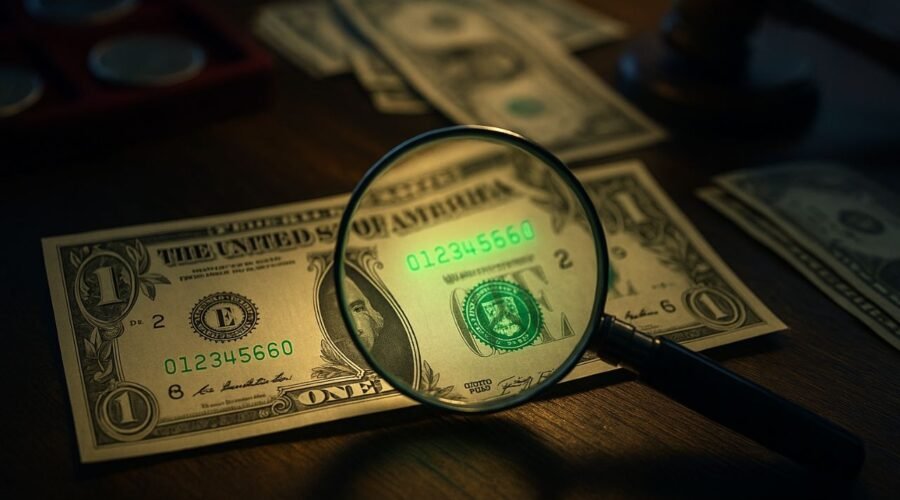That $1 Bill Could Be $10,000- Fancy Serial Numbers To Watch For
If you ever glance at the back of your dollar bill and see a serial number like “00000007” or “77777777”, you might be sitting on a tiny gold mine. Collectors pay hundreds, sometimes thousands, for fancy serial numbers—those unique digit patterns that elevate a bill from faceless currency to a coveted collector’s item.
In rare cases, a simple $1 bill has sold for $10,000 or more because of its serial number. Let’s dive into what makes a serial number valuable, how much they can fetch, and how to spot one in your wallet.
What Makes a Serial Number “Fancy”?
A “fancy” serial number follows a pattern that is rare or visually striking. Here are common types of collectible serials:
- Solid / Repeats: All digits are identical, e.g. 11111111, 99999999
- Low-Number / Leading Zeros: Many leading zeros, like 00000023
- High-Number / Trailing 9s: Many 9s at the end, like 99999990
- Ladder / Sequence: Digits ascending or descending, e.g. 12345678 or 87654321
- Radar / Palindrome: Reads the same forward and backward, e.g. 12344321
- Repeater Patterns: A small block repeats, e.g. 12121212, 34343434
- Birthday / Date Sequences: Looks like MMDDYYYY, e.g. 09031992
Collectors prize these patterns especially when the note is in uncirculated or high grade condition because condition greatly affects value.
How Much Are Fancy Serial Bills Worth?
Here’s a table with rough valuation ranges (based on recent auctions and collector sales for U.S. small-denomination notes in good condition):
| Serial Type | Sample Pattern | Estimated Value* |
|---|---|---|
| Solid / Repeats | 77777777 | $500 – $5,000+ |
| Low Number | 00000012 | $100 – $500 |
| Ladder / Sequence | 12345678 | $800 – $7,500 |
| Radar / Palindrome | 12344321 | $200 – $3,000 |
| Repeater Pattern | 12121212 | $150 – $1,000 |
| High Number (Trailing 9s) | 99999990 | $100 – $500 |
*Values are approximate and depend heavily on condition (grading), denomination, series year, and collector demand. A well-graded note with the same serial could bring 2x or 10x the estimates above.
In fact, a recent $20 bill with serial 01234567 (a ladder) sold for about $7,500. Other bills with solid digits or radar patterns have commanded thousands of dollars at auction, especially when certified and graded.
Why Some Fancy Bills Fetch Big Premiums
- Scarcity: Only a tiny fraction of notes printed land with such patterns.
- Condition: Mint or near-mint condition (no folds, stains, crisp ink) is essential.
- Denomination & Year: Some series or denominations are more hunted.
- Certification: Grading services authenticate and grade the bill, boosting trust and price.
- Collector Trend: Demand shifts; a serial pattern might be “hot” one year and cold the next.
How to Check Your Bills (Smart Steps)
- Examine all your notes—don’t just toss the small ones.
- Look for patterns: repeats, palindromes, ladders, or many zeros.
- Check series & condition: later series or worn notes fetch less.
- Get it graded: certified grading improves buyer confidence.
- Research comparable sales: look up recent auctions to see what similar notes sold for.
Risks, Pitfalls & Reality Check
- Many bills with “cool” numbers are overrated by owners but sell at just a small premium.
- Circulated notes (folded, creased, handled) often lose much of the collectible value.
- Frauds exist—don’t accept random appraisal claims. Always use reputable graders.
- Even a fancy serial doesn’t guarantee it sells for $10,000—market conditions, buyer interest, and exposure all matter.
Your everyday $1 bill might be hiding a stunning secret. Because of fancy serial numbers—rare patterns like solid sets, ladders, palindromes, and low or high extremes—ordinary bills can fetch extraordinary sums. Getting your bill graded and connecting with the right collectors are key steps.
While very few bills reach the $10,000+ mark, the possibility means every time you dig through your wallet, don’t skip that crisp one dollar—you might find a tiny treasure worth far more than face value.
FAQs
Could that $1 really sell for $10,000?
Yes—in rare cases. If you have a super rare serial (solid, ladder, palindrome) in pristine condition and find the right collector, it’s possible, though not common.
Which pattern is most valuable?
Typically solid numbers (all same digit) and low-number with many zeros top the charts. Ladder and radar notes are also highly desirable.
Should I send it to get graded first?
Yes. A note graded and authenticated by a respected service (e.g. PCGS, PMG) often sells for much higher and attracts serious buyers.


Leave a Reply